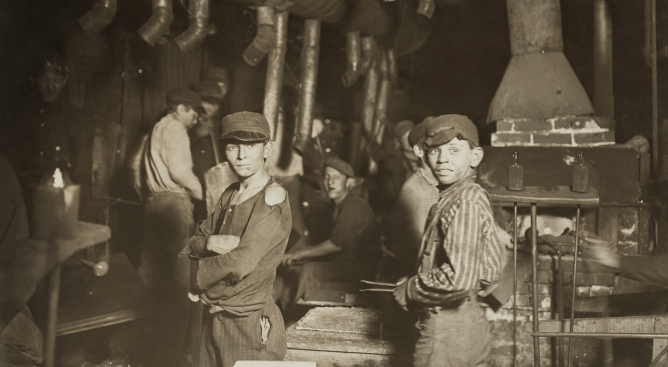The first blog in our series of the history of asbestos detailed when asbestos was first dated by archeologists - the Stone Age some 750,000 years ago up until its use by the Romans and Egyptians. Our second blog studied the Middle Ages up to the 17th century. We now turn our attention to the 1800s and up to the present day and discovering when people seriously became aware of asbestos-related diseases.
The use of asbestos was more widely utilised with the advent of the Industrial Revolution whose timeframe is debated, but generally accepted to be from around 1760-1840. Prior to that, paper made from asbestos was unearthed in Italy dating back to the early 1700s and also there are records of the Italian government using its fibres in bank notes. Many years later, during the mid-1850s, the fire brigade of Paris used it in clothing and helmets.
The Industrial Revolution was a global phenomenon as the world transitioned from a human economy towards manufacturing - the result being more efficient and robust processes.
The mining of asbestos across the world
In South Africa, crocidolite (known as blue asbestos) was discovered in the early part of the 19th century and then in the early 1900s, amosite (brown asbestos) was found, this time in the Transvaal. Further discoveries of chrysotile (white asbestos) in Swaziland and Zimbabwe saw it being mined and sent around the world.
In Quebec, Canada chrysotile was discovered in the Thetford Township in 1876 which led to the first commercial asbestos mines appearing in the world. In the 1880s, the Australians got in on the act and were mining asbestos in Jones Creek, New South Wales.
In Europe, the early 1870s witnessed the emergence of large asbestos industries in Scotland, Germany and England whilst Italy was already mining tremolite asbestos. By the turn of the new century (the Edwardian period 1901-10) anthophyllite asbestos was being mined in Finland.
Various uses of asbestos in the UK
In the late 1870s, asbestos use in the UK was applied to ship building, steam engineering, power generation and construction and resulted in asbestos being mined at a scale necessary to meet the demand of not just the UK, but many countries. It was sought after for many reasons: not only was it fire retardant but it was also a very economical resource. It became the go-to solution since it was resistant to chemicals, heat, water and electricity - exactly what the Industry Revolution was calling for with its turbines, boilers, ovens and electrical generators.
Asbestos production goes into overdrive
Once asbestos could be mined by mechanical means rather than human hands, production increased on an industrial scale. Steam-driven machinery and new mining methods meant that asbestos could be manufactured more quickly and in turn, could be applied to more uses.
In the United States, Henry Ward Johns was only 21 when he established the H.W. Johns Manufacturing Company in lower Manhattan in 1858. Mining anthophyllite asbestos from Staten Island, the industrialist sold fireproof roofing material and later went on to expand the use of asbestos. When his company merged with Manville Covering Company in 1901, Johns Manville went on to become the global leader in the manufacture of asbestos-containing products.
(Tragically, Henry Ward Johns died from ‘dust phthisis pneumonitis’ now known as asbestosis in 1898.)
In 1896, asbestos was first used in the application of brake linings in horseless carriages by Ferodo in the UK and in 1899, the first patent for the manufacture of cement sheets containing asbestos was issued in Germany. Germany’s neighbour Austria was producing high pressure asbestos gaskets in 1900 by Klinger. In 1913, Italy was the first to develop asbestos pipes.
And global production continued. Data from 1910 reports that over 109,000 metric tons was produced worldwide - triple that recorded in 1900. Supplied by Canada, the world’s largest user of asbestos with demand for mass-produced construction materials was the United States. Only with the outbreak of WW1 followed by the Great Depression, did the growth of its asbestos industry slow down only to regain momentum during the Second World War.
When did people start to be aware of the dangers of asbestos?
In 1897 in Austria, a doctor came to the conclusion that his patient’s pulmonary issues were due to him inhaling asbestos.
In the UK where regular inspections of factories had been conducted since 1833 to protect workers’ health and safety, a report in 1898 by Lucy Deane Streatfield first voiced concerns about the health risks arising from exposure to asbestos. The conclusion that ‘widespread damage and injury of the lungs, [was] due to the dusty surrounding of the asbestos mill’ was ignored.
In 1899, a 33 year old man suffering with bronchitis shared with Dr Montague Murray at London’s Charing Cross Hospital that he had worked in an asbestos factory. Explaining that all his work colleagues had died in their thirties, when the man tragically died, Dr Murray undertook a post mortem and discovered that the man’s lungs showed heavy scarring and evidence of asbestos fibres.
Further reports of fibrosis deaths in asbestos factories in Italy and France tallied with those in the U.S particularly when the deceased were so young; we know that US and Canadian insurance companies started to reduce the scope of insurance for those working in the asbestos industry as early as 1908 whilst simultaneously increasing premiums.
By 1930, it was decided there that was indeed a connection between asbestos and lung cancer but it was not for a further 30 years that asbestos-related diseases were fully understood.
Governments get involved - the issuing of bans
Despite rising concerns towards the back end of the 19th century and the beginning of the 20th century, those who had a vested interest in its continued use made sure the asbestos industry continued. Unbelievably, asbestos’ popularity did not peak in the EU until the 1970s.
As asbestos and its health risks became more prevalent in the news and now in the public domain, governments made the move to ban it. Australia stopped mining asbestos in 1984 whilst a year later, the UK began to ban some types. By 2000, all types were banned in the UK.
In the United States, mining was at its highest during the 1960s and 1970s particularly on the East Coast and California. In 2002, the last active asbestos mine was the King City Asbestos Company (KCAC) mine in west-central California.
The history of asbestos
We hope our series of blogs have offered some insight into the history of asbestos and how, through the ages its composition has led to its use in a myriad of applications. It’s quite clear that as a cheaper, natural resource many corporations exploited its many benefits but tragically, those working with it were not protected - and many are now suffering its legacy as a result.





